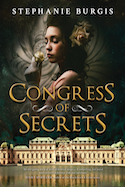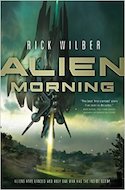The Future Alternative Past: our inaugural science fiction, fantasy, and horror column
New column! New Every month, Nisi Shawl is going to present us with news and updates from her perch overlooking the world of science-fiction, fantasy, and horror. Welcome Nisi!
Hello from your new skiffy columnist! I’m very gratified that I’ve been asked to provide you with monthly doses of clear-eyed science-fiction-fantasy-and-horror analysis, accompanied by the lamentation, kvelling, and Inside Baseball-like scuttlebutt you’d expect from a longtime reader and writer of that sort of thing. I promise to guide both trufen and neos (if you don’t know who those terms describe, you’re the latter) through the fantastic genres’ winding byways in the most pleasurable and interesting manner possible. In addition to my more general genre outpourings I’ve been charged with noting any upcoming conventions you may be interested in, and bringing you brief looks at recently published books.
Let’s begin with the conventions. Why?
Well, one major difference between science fiction/fantasy/horror (abbreviated hereinafter as SFFH) and other literatures is the communitarian legacy of early science fiction conventions. Damon Knight and the Futurians — a science fiction fan club rather than a surf rock band — organized the first World Science Fiction Convention, or Worldcon, way back in 1939. Though frequently eschewed by people of color, who can feel unwelcome in some of SFFH fandom’s whiter iterations, conventions (aka “cons”) have formed the genre’s powerful exoskeleton for almost 80 years now. Admittedly there were a couple of decades when falling con attendance rates were taken as predictors of SFFH’s fast-approaching demise. And many of those who did attend during the late 70s, the 80s, and even the early 90s, were as grey as they were white, leading to the expectation that con-going fandom as an institution would die of old age.
Lately, though, newer cons such as San Diego Comic-Con have sprung into existence. Appealing to a broader and often younger demographic, they embrace art forms reviled by some trufen (SFFH fandom’s hardened nerdcore): comics, movies, and even cartoons!
Though there’s no doubt some overlap in their memberships, two good examples of what I’m talking about can be found a couple hundred miles south of Seattle, in Portland, Oregon. By the time you read this, Orycon 38 (November 18 - 20, 2016) will be underway or over. As the number indicates, this is the 38th consecutive Orycon convention. I’ve attended quite a few. The panels, workshops, author signings, dances, freebie tables, art show, and vendor areas I’ve grown used to at other cons are always in evidence, with local literary luminaries supplementing the presence of national and international Guests of Honor such as Peter S. Beagle, Octavia E. Butler, and Steven Barnes.
But though you're probably not going to make Orycon, you’ve still got a good shot at attending Newcon PDX 5 (December 30, 2016 - January 1, 2017). Again as evidenced by the number, this is Newcon PDX the fifth. I’ve never been to even one of these. Events promised on the website range from a Cosplay Contest to a Swimsuit Cosplay Contest (“cosplay” is costuming based on characters found in popular books and shows), from gaming to tabletop gaming, from karaoke to a “Lip Sync Battle Royale.” As the self-proclaimed convention for “every flavor of nerd,” Newcon PDX of course offers panels, too, as well as special areas for vendors and artists. Photos of past attendees show a crowd with a hearteningly diverse racial make-up.
This last point is a great one because the historic whiteness of con-going fandom has been damaging — to POC who read and wrote and acted in SFFH works but felt unwelcome in its social spaces, and also to fandom as a whole, since they’re thus denied firsthand experience of our secret superpowers — or, to put that less fancifully, our perspectives and backgrounds. In 2009’s RaceFail, our participation in social media made it impossible for our existence to be denied, and POC also developed our own virtual and IRL safe spaces: the Carl Brandon Society advocated for them and organized panels on how to increase inclusivity at cons in particular and within fantastic literature as a whole, while groups such as the State of Black Science Fiction carved out online spaces for nerd-of-color community-building. Then, in 2010, Kate Nepveu ran her first auction to raise funds for Con or Bust, a nonprofit she created to offer scholarships to self-identified POC who want to attend cons. At first under the umbrella of the Carl Brandon Society and now on its own, Con or Bust has raised and distributed tens of thousands of dollars. That’s sadly still very necessary, as my write-up of the 2015 James Tiptree, Jr. Symposium at Eugene’s University of Oregon shows. Perhaps this year’s symposium, held December 2nd and 3rd in honor of writing goddess Ursula K. Le Guin, will be a bit more variegated.
Recent books recently read:


